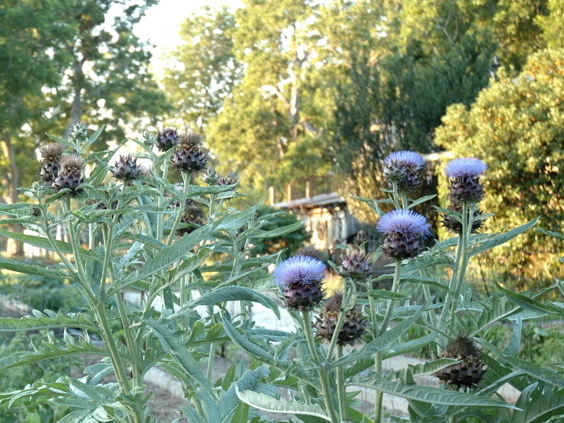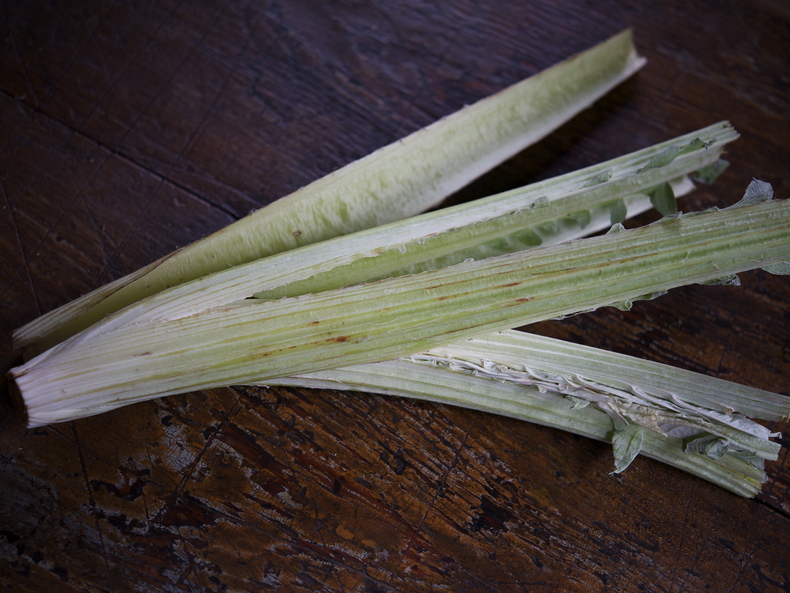5.4.10 Discover Cardoons
This cardoon looks a lot like celery after some very hard living, but it’s actually from the artichoke family—Cynara cardunculus. You may recognize its linguistic similarity to Cynar, the Italian artichoke-based bitter aperitivo also produced by Campari. The plant is a perennial with silvery-green leaves and edible stalks that can grow up to 7’ tall. It has some sharp, almost razor-like edges that you don’t really want to brush up against. When the plant flowers, the blossom looks like a large purple thistle. Though it’s often regarded as a nuisance weed in North America, other more civilized cultures have long regarded it as good eating. When the Italians grow it, they bend the young stalks down to the ground and bury them in the earth. This blanches the stalks, reducing bitterness and making them so tender they’re even served raw with bagna cauda or a similar achovy-based sauce. Cardoons are also delicious fried or made in classic Roman style, blanketed with a buttery bechamel sauce, as in my recipe below.

Interesting side note: An extract made from dried cardoon flowers is used to curdle milk for cheese. It’s not as strong as calf rennet, so curdling happens more slowly and can produce a creamier-textured cheese. It also gives the cheese more of a tang, as in the lovely Spanish Torta del Casar.Cardoons Au Gratinserves 4 1 large bunch cardoonsjuice of 1/2 lemon1 tablespoon salt1 cup milk1 cup buttermilk (this gives it a nice tang)2 tablespoons butter2 tablespoons flour (I used a gluten-free mix)1/2 cup pecorino or sharp cheddar1 cup Parmesan cheese, gratedSlice the cardoons across the base and trim the tips, removing leaves and any brown edges. Discard any hollow stalks, retaining only the firm pale-green ones. With a vegetable peeler or sharp knife, peel away any tough outer strings.Cut crosswise into 2-inch pieces, and place in a bowl of cold water along with the lemon juice. Leave to soak overnight or for at least six hours in the refrigerator.Drain cardoons and place in a large pot with fresh cold water and a pinch of salt. Bring to a boil and then simmer until tender; time depends on the cardoons but plan on at least 45 minutes. Drain. While the cardoons are cooking, preheat the oven to 375 and make the sauce.In a small pot, add the salt to the milks and gently heat. In larger pot, melt the butter over low heat. Slowly sprinkle flour into the melted butter, stirring constantly with a wooden spoon to avoid lumps. When the mixture is smooth and shiny, begin to add the warmed milks a little at a time, stirring constantly. Continue to heat and stir until mixture is almost at a boil. Add the pecorino or cheddar and half the Parmesan, and let it melt into the sauce. Mix the cardoons into the sauce, stirring to coat well, and pour it all into a buttered roasting pan.Sprinkle with remaining Parmesan and bake until golden brown, about 30 minutes. Serve this alongside a roasted meat or fish, or simply with a green salad for lunch.







3 Comments